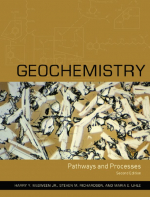Добрый день, Коллеги. Важное сообщение, просьба принять участие. Музей Ферсмана ищет помощь для реставрационных работ в помещении. Подробности по ссылке
Geochemistry. Pathways and processes / Геохимия. Пути и процессы
The modern geologist with no knowledge of geochemistry will be severely limited. Indeed, geochemistry now pervades the discipline—providing the basis for measurement of geologic time, allowing critical insights into the Earth’s inaccessible interior, aiding in the exploration for economic resources, understanding how we are altering our environment, and unraveling the complex workings of geochemical systems on the Earth and its neighboring planets. Geochemical reasoning reveals both processes and pathways, as the book’s title implies.
Our book is about chemistry, written expressly for geologists. To be more specific, it is a text we hope will be used to introduce advanced undergraduate and graduate students to the basic principles of geochemistry. It may even inspire some to explore further and to become geochemists themselves. Whether that happens or not, our major objective is to help geology students gain that manifest advantage noted in the quote above by showing that concepts from chemistry have a place in all corners of geology. The ideas in this book should be useful to all practicing geologists, from petrologists to paleontologists, from geophysicists to astrogeologists.
Students exposed to a new discipline should expect to spend some time assimilating its vocabulary and theoretical underpinnings. It isn’t long, though, before most students begin to ask, “How can I use it?” Geologists, commonly being rather practical people, reach this point perhaps earlier than most scientists. In this book, therefore, we have tried not to just talk about geochemical theory, but to show how its principles can be used to solve problems. We have integrated into each chapter a number of worked problems, solved step by step to demonstrate the way that ideas can be put to practical use. In most cases we have devised problems that are based on published research, so that the student can relate abstract principles to the real concerns of geologists.
Working the problems at the end of each chapter will further reinforce what has been covered in the text. This attention to problem solving reflects our belief that geochemistry, beyond the most rudimentary level, is quantitative. To answer real questions about the chemical behavior of the Earth, a geologist must be prepared to manipulate quantitative data and perform calculations.
We address this philosophy directly at the end of chapter 1. It should be understood at the outset, however, that most questions at the level of this book can be answered by anyone with a standard undergraduate background in the sciences. We assume only that the student has had a year of college-level chemistry and a year of calculus. In this second edition, we have added a chapter (chapter 2) to help students put a geological frame around fundamental concepts in chemistry. As in the earlier edition, we have outlined more advanced methods for handling a few specialized math concepts, such as partial derivatives, in an appendix. With these aids, most routine approaches to solving geochemical problems should already be within the student’s reach. <...>




